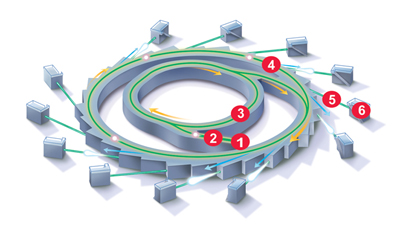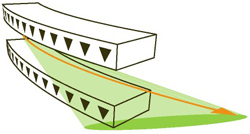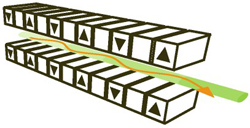 |
|
Electrons are generated in the centre (electron gun) and accelerated to 99.9997% of the speed of light by the linear accelerator (linac). The electrons are then transferred to the booster ring, where they are increased in energy. They are then transferred to the outer storage ring.
The electrons are circulated around the storage ring by a series of magnets separated by straight sections. As the electrons are deflected through the magnetic field created by the magnets, they give off electromagnetic radiation, so that at each bending magnet a beam of synchrotron light is produced.

Illustration of a bending magnet.
At each deflection of the electron path a beam of light is produced. The effect is similar to the sweeping of a search light.
These beams can be captured and focussed to a specific wavelength appropriate for a particular technique.
Insertion Devices
It was found that the intensity of light can be significantly increased by the use of 'insertion devices' in the straight sections of the ring.
There are two classes of insertion devices. One is a multipole wiggler (MPW) in which a cone of light is emitted at each bend in the 'wiggle' so that the cones of light superimpose on each other, the intensity increasing with the number of bends.

Illustration of a multipole wiggler.
At the peak of each wave a beam of light is emitted. These beams reinforce each other and appear as a broad beam of incoherent synchrotron light when viewed in the horizontal plane ahead of the wiggler.
The second type of device is an undulator. It uses less powerful magnets to produce gentler undulations of the beam. In this case, the light cones just overlap and interfere with each other, so that certain wavelengths of light are enhanced perhaps by 10,000 times. These wavelengths can be changed by altering the gap between the component magnets so that the light is tunable to specific wavelengths.

Illustration of an undulator.
The poles produce less deflection of the electron beam. This results in a narrow beam of coherent synchrotron light, with certain frequencies amplified by up to 10,000 times.
Current ('third generation') designs of synchrotrons aim to optimise the intensity that can be obtained from insertion devices. In particular, attention is given to the size and positioning of the straight sections that accommodate the insertion devices.
The Australian Synchrotron is an advanced 'third generation' design. It uses the three different types of light sources (bending magnets, multipole wigglers and undulators) to enable a wide range of advanced experiments or measurements to be carried out.
